8 Postural Stability in Motor Control
Balance
Crystal McKinney, MS
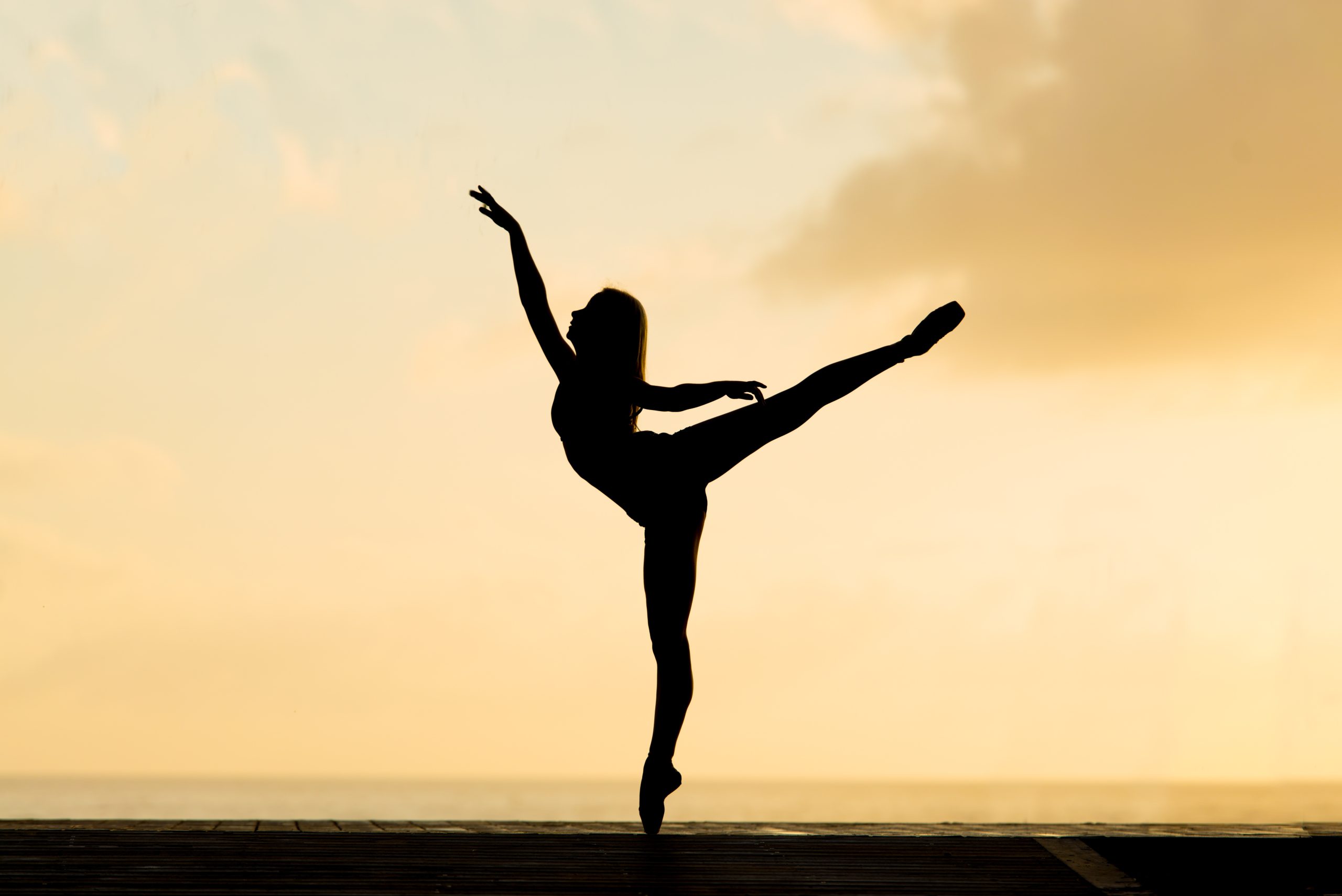
IntroductionThe role of balance in human movement control and coordination is the body’s ability to maintain center of mass over its base of support. Postural control is the ability to coordinate muscle response synergies and control body movement in space based on information planned in frontal cortex and motor cortex, coordinated in brainstem and spinal networks and generation of forces in motor neurons and muscles (Shumway-cook, 2004). Control of balance and postural orientation work together by interacting between sensory systems, nervous systems, and the musculoskeletal system. Center of gravity (COG) is a term that is newly redefined as the vertical projection of center of mass relative to base of support rather than its originally theorized idea of most concentrated density of mass (Redefining the Center of Gravity, 2010). Center of pressure (COP) continuously orbits center of mass to keep within its supported base range (Benda et al., 1994).
Humans are able to improve balance as they move through daily tasks such are walking bending over, standing up and activities that improve proprioceptive control and strengthen postural muscles including agility drills, functional strength training, yoga, tai chi. Through my life experience I have been fascinated by balance as early as performing karate during my childhood and continues to be a forefront in my life today through my teachings of yoga. My yoga practice continues to remind me of the playfulness of life as I train towards new skills and experience different methods or controlling my body in space.
base of support
The area of standing surface that the body makes contact with is the foundational that balance builds upon, the base of support. The orientation of all body parts that are stacked over the surface area determine how the support of postural stability will be distributed. In other words, changing body position changes the distribution of weight across the area of base of support. An example of a wider base of support is a compound squat standing with both plantar surfaces of feet shoulder-width apart hinging at the hips and knees descending to a seated position and returning to standing position. In contrast, a unilateral split squat has a more narrow base of support with base of support weight distributed mostly on the front foot’s plantar surface in front of the back foot’s ball planted on the surface and heel lifted. Humans have been experimenting with challenging balance through biomechanical changes by wearing high heels for decades, holding the foot in plantar flexion activates more demand from gastrocnemius and soleus muscles as well as achilles tendon while weight of body shifts forward over narrow base of support. This narrow shift in base of support also increases activation of intrinsic foot muscles that control toe position and arches of feet that allow flexibility in weight distribution for differentiating terrain.
When feet are not arched they are referred to as fallen arches, flat feet, or pes planus where the medial longitudinal arch of the foot makes or comes close to making contact with the surface area, a common foot deformity in infants and is significantly correlated with obesity in children (Raj et al. 2022). Flat feet create more difficulty in maintaining postural stability and can be acquired through continual high impact sports (i.e. running, soccer, basketball) or improper footwear that do not support arches or allow wide enough toe space (Ross 1997). Improvement to balance can be achieved with fallen arches by footwear that is appropriately sized and shaped to create space for foot mobility as well as specific to activity and replaced every few months to also ensure proper support of joints. Training to improve arches can include feet and toe strengthening exercises by planting each toe individually beginning with pinkie toe slowly through to big toe as well as reverse direction. Other exercises include towel curls, planting foot on ground over a towel and gripping toes towards heels holding position for a few seconds then repeating a few repetitions regularly.
The “sense” of balance
Somatosensory
The somatosensory system is a combination of proprioception and tactile information that allows someone to denote a sensation anywhere in the body by localizing the sense at the organ (Oxford Languages Dictionary). Understanding one’s own body position in space relative to other surfaces that surround their environment is somatosensory information that contributes to one’s balance. Children are still developing their own perception and ability to orient their body, research shows that children have more variability in their postural sway than adults due to their developing perception and differentiation task relevancies from sensory stimulus (Barela et al. 2003). The “moving room” paradigm shows how children are still developing their somatosensory system by controlling the visual environment surrounding an infant, whenposture the environment is disrupted with movement such as a ceiling fan or moving walls the infant’s upright posture is also disrupted (Lee & Aronson, 1974). This is how we know children depend on visual information in respect to their location to maintain control in balance as they continue to experience how they might respond to environment changes throughout their own locomotion.
Visual
The visual system informs our body about its position in relation to other objects in the environment by visual comparison of self to reference points in the environment. The nervous system processes visual information and executes motor commands to alter muscle tone and joint stiffness in order to maintain control and postural stability of the body through actions of stabilizing the head and reacting to environmental cues.
Vestibular
The vestibular system depends on the inner ear’s semicircular canals detection of head position relative to gravity through acceleration of linear and angular shifts in head position (Postural Control in Children | SpringerLink, 2003). The body compensates for orientation of the head when the plane of motion shifts, the cerebellum coordinates movement based on that sensory information. When standing in an upright position and looking up towards the sky, body orientation shifts as well as the visual information surrounding, leading to balance disruption. Weight is shifted to neck and back muscles to support weight of head so the cerebellum coordinates a shift in muscle tone activation to support the new head position and recalibrate its spatial orientation by perceiving new environmental information and compensating for new body position in order to prevent loss of balance (Troiani et al., 2005). When vestibular system is not fully functional or developed conflicting input will be sent to the cerebellum and cause loss of balance, dizziness and nausea causing vertigo (Somisetty & M Das, 2023).
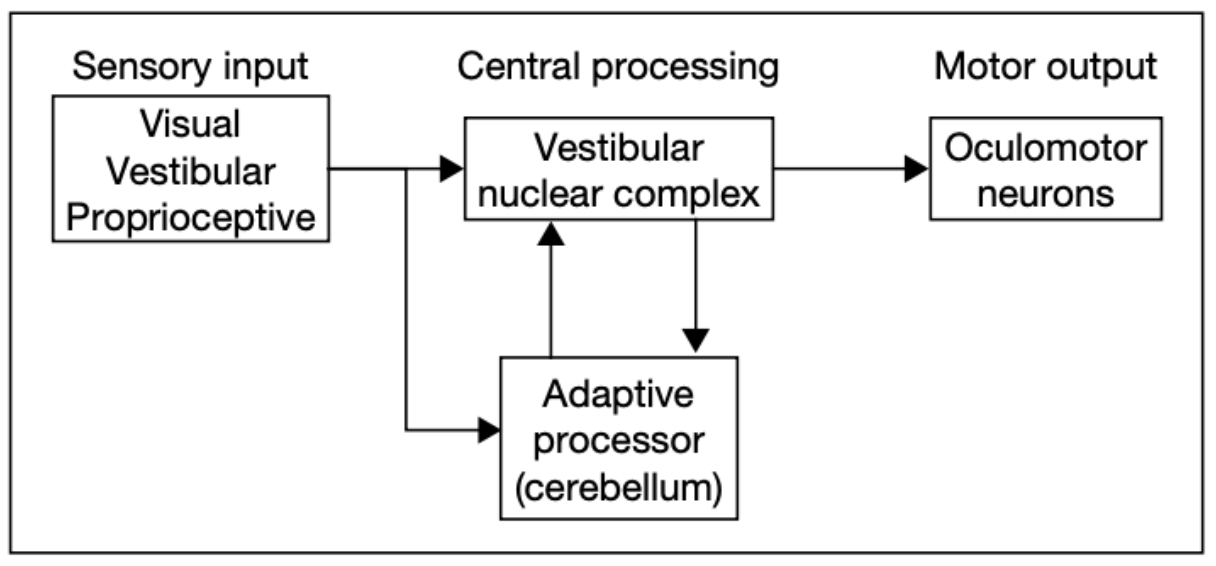
The process of shifting the body compensates eye movement to maintain postural stability in the visual field through the head-body righting reflex vestibulo-ocular reflex (VOR). When looking to the left, our weight shifts towards the right foot because the eyes will veer to the right despite head orientation pointing left (Troiani et al., 2005). The VOR is a head-stabilization-in-space anticipatory control that acts in this compensation to maintain postural stability for the visual environment while the change in head orientation occurs (Glasauer, 2007). Compensatory body movements are generated by the vestibulospinal reflex (VSR) that stabilize posture and maintain head position continuously working with VOR to central nervous system needs (Somisetty & M Das, 2023). This is an example of how visual, vestibular, and somatosensory systems all work in union as sensory feedback to maintain balance and control of posture.
Action systems in postural control
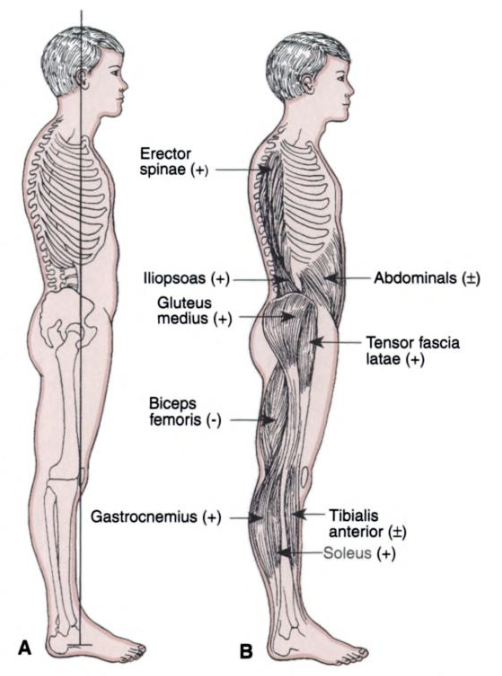
Alignment
Proper alignment of postural stance allows for body to maintain equilibrium with minimal energy expenditure from muscular effort. The vertical line of gravity aligns with the midline of body posture between mastoid process, just in front of shoulder joints, hip joints or just behind, and just in front of ankle joints (Shumway-cook, 2004).
Muscle Tone
The nervous system includes the brain, spinal cord, and peripheral nerves that receive and integrate information from the visual, vestibular, and somatosensory systems. The motor control cortex then commands stiffness in joints and activity in muscle tone to maintain balance. The force generated by muscles stabilize the body and keep the joints maintained in their positions, with the weight of the body supporting the frame of the skeleton. Human senses allow processing of sensory information in regards to position of body and its movement and orientation relative to space.
Postural Tone
The nervous system activates specific muscles prior to movement to maintain balance and postural tone and control. Rapid activation of specific muscles in response to unexpected disturbances. Activation of specific muscles maintain balance and allow control of body position. Stabilization of joints occurs through co-contraction by simultaneous activation of agonist and antagonist muscles. Older adults have a higher need to protect their postural stability than younger people due to joint stiffness, they have a decrease in body sway because their lower extremities have larger muscle co-contraction than in that of younger people. (Iwamoto et al., 2017) (Melzer et al., 2001) (Manchester et al., 1989) To compensate for errors in postural sway larger inputs of sway and larger outputs of co-contractions act in response to age’s effect on decreased sensory input and motor output. Range of motion decreases with age leading to loss of spinal flexibility and posture may be flexed or swooped with head forwards, kyphosis, lordosis, hip flexion and or knee flexion (Shumway-cook, 2004). In relation to all other joints spinal extensions declines the greatest in flexibility associated with aging. Greater differences amongst oldest populations compared to youngest populations primarily caused by their lack of activities performing backward extensions (Einkauf et al., 1987) (Saidu et al., 2011).
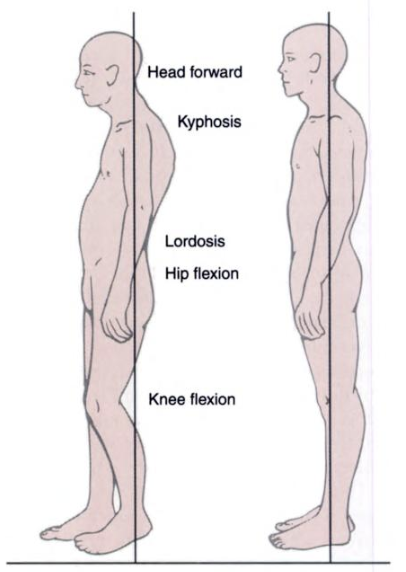
Firing rate of joint receptors increases with muscle co-contraction. Strength training programs show improvement in balance, older populations may prevent falling by targeting hip abductors, knee extensors and flexors, and ankle dorsiflexors in these programs. By participating in strength training programs this will also maintain muscle mass successively maintaining function of muscles and joint flexibility. Increased demands on skeletal muscle minimize and may eliminate declines related to age in balance (Kirkendall & Garrett, 1998).
feedback control & feedforward control
Feedback information is from the periphery of task outcome. Secondary task performances do not always have an effect on balance (Stoffregen et al., 2006). Trembling feedback is the deviation away from the reference point. Feedforward information is from the central executor regarding tasks to perform. Rambling is oscillations due to reference point migration. In children more sway is related to the variability in feedforward control or feedback control, it is most likely that there is greater feedforward than feedback. Standing in an upright stance is maintained by our control of degrees of freedom at ankle, knee, hip, and trunk. The body does not behave in a rigid structure above the ankles, the inverted pendulum (Elhasairi & Pechev, 2015)
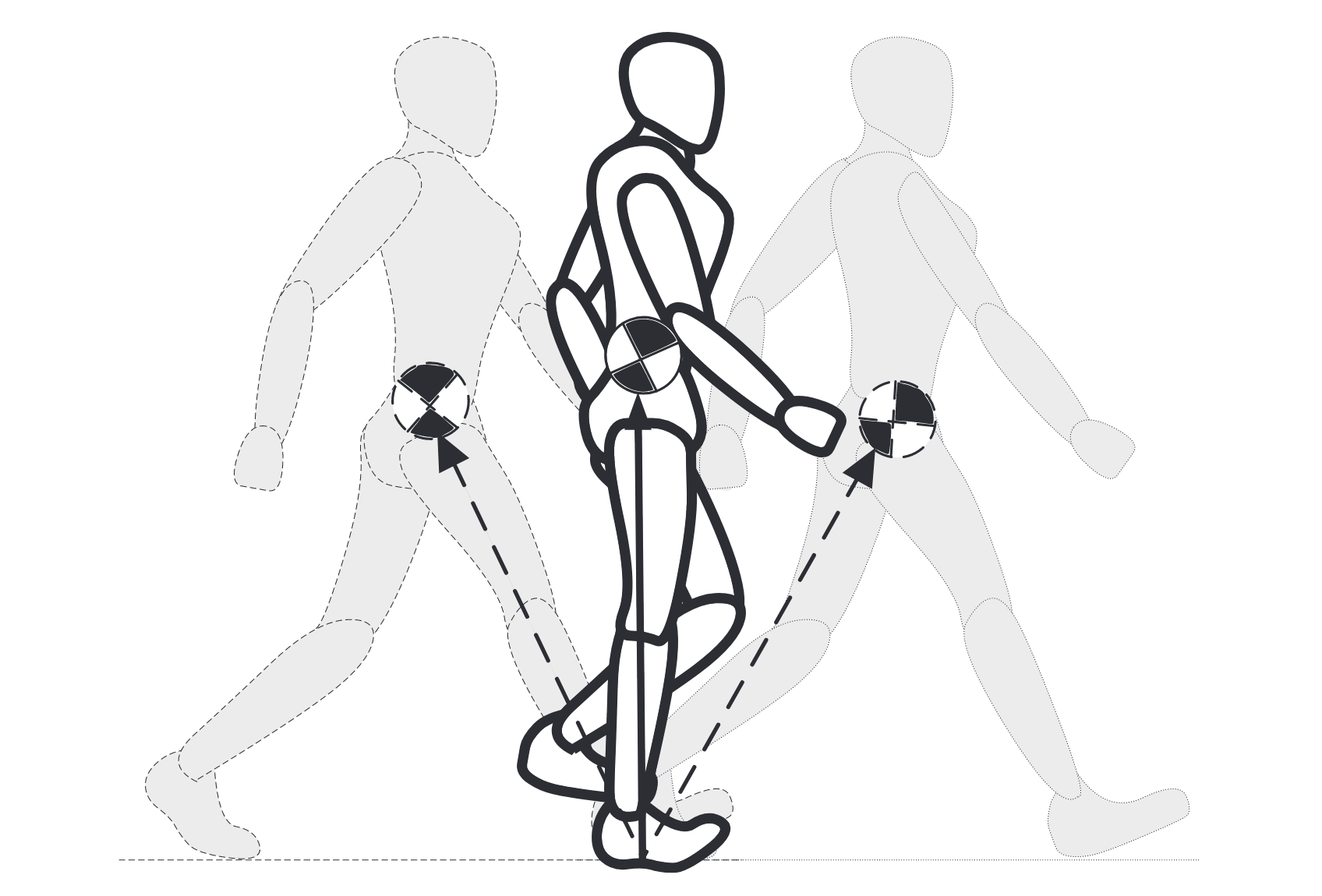
aging
Decreased functional mobility results from institutionalization of older populations and contributes to their risk of poor balance, number of falls, injuries, and increased fear of falling contributing to the cycle of decreased mobility. Age-related decrease in postural control due to input of vision worsening and somatosensory input declining in joint mobility, muscle mass and force, proprioceptive acuity, and postural stability (Hurley, Rees & Newham, 1998). Age-related changes in balance control are associated with children’s use of sensory information to determine a reference position, this is why older children have noise levels similar to adults and sway more (Barela et al. 2003). Before infants are even able to sit up on their own they have perception of the amplitude and direction of their postural sway. Their perspective and action coupling will vary as they age and advance motor development.
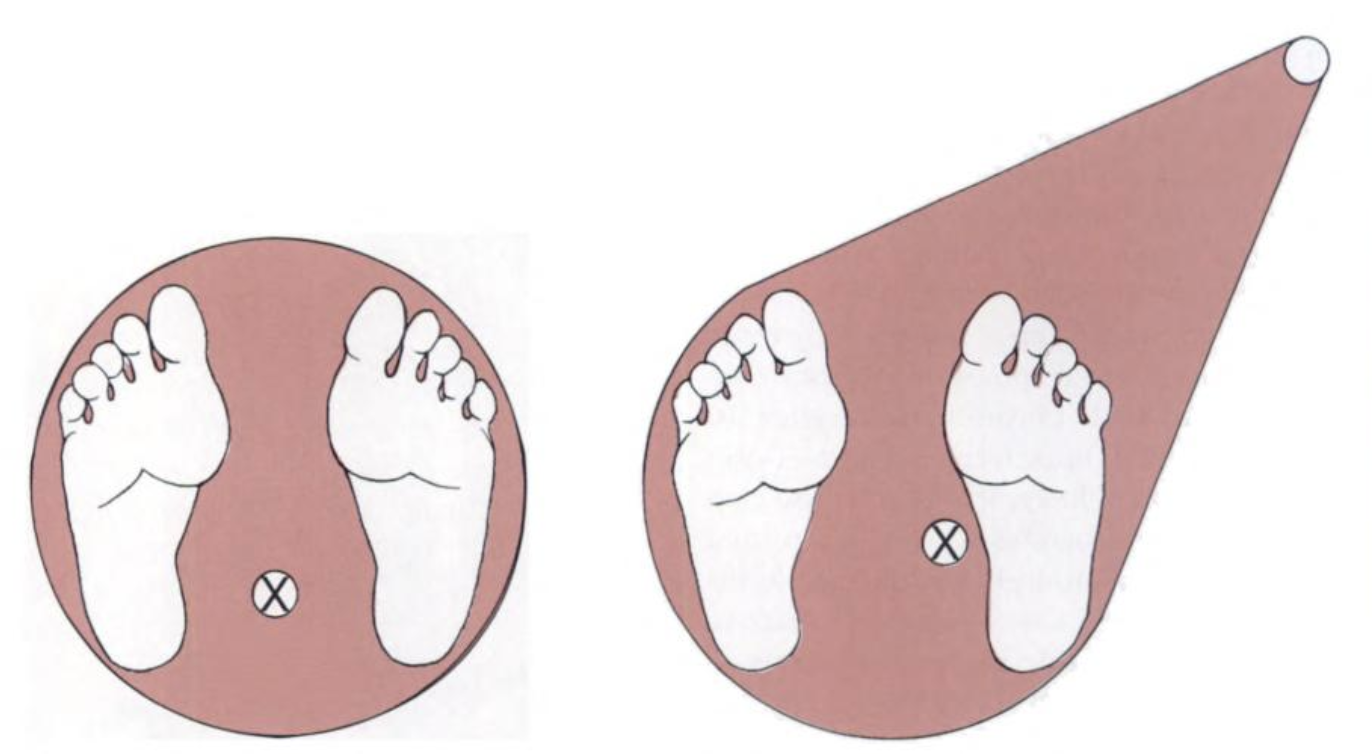
Activity
Let’s get a sense for how our balance begins to shift when we alter input from visual, vestibular, and somatosensory systems.
Bring awareness to each addition of movement, how is postural stability of pose altered? Remember how change of base of support will distribute differently when the surface area body makes contact with is smaller or larger in size or shape. Start a stopwatch for each new stage to see how long you are able to maintain stabilization.
- Begin an arm’s length reach away from wall with a clear area of space. From a standing posture, slowly lift one leg until quadricep is parallel to the ground. For an extra challenge extend the lifted leg and begin slowly pointing toes to plantar flexion and flexing toes to dorsiflexion. Hold this pose!
- Now let’s play around with altering senses starting with visual system, close your eyes.
- Now with eyes open to alter vestibular system, tilt head up towards the sky. This system could also be altered by making the standing surface area unsteady, standing on a pillow or foam surface.
- To alter environment and include more tactile information, reach arm out so palm makes contact with wall.
- All of these senses work together to maintain balance, combine them all noticing how each sense depends on information of another. Reach palm out to wall, tilt head up to sky, close eyes.
Which stage were you able to maintain balance for the longest? Did you find it to be easier or more challenging when all altered senses were combined?
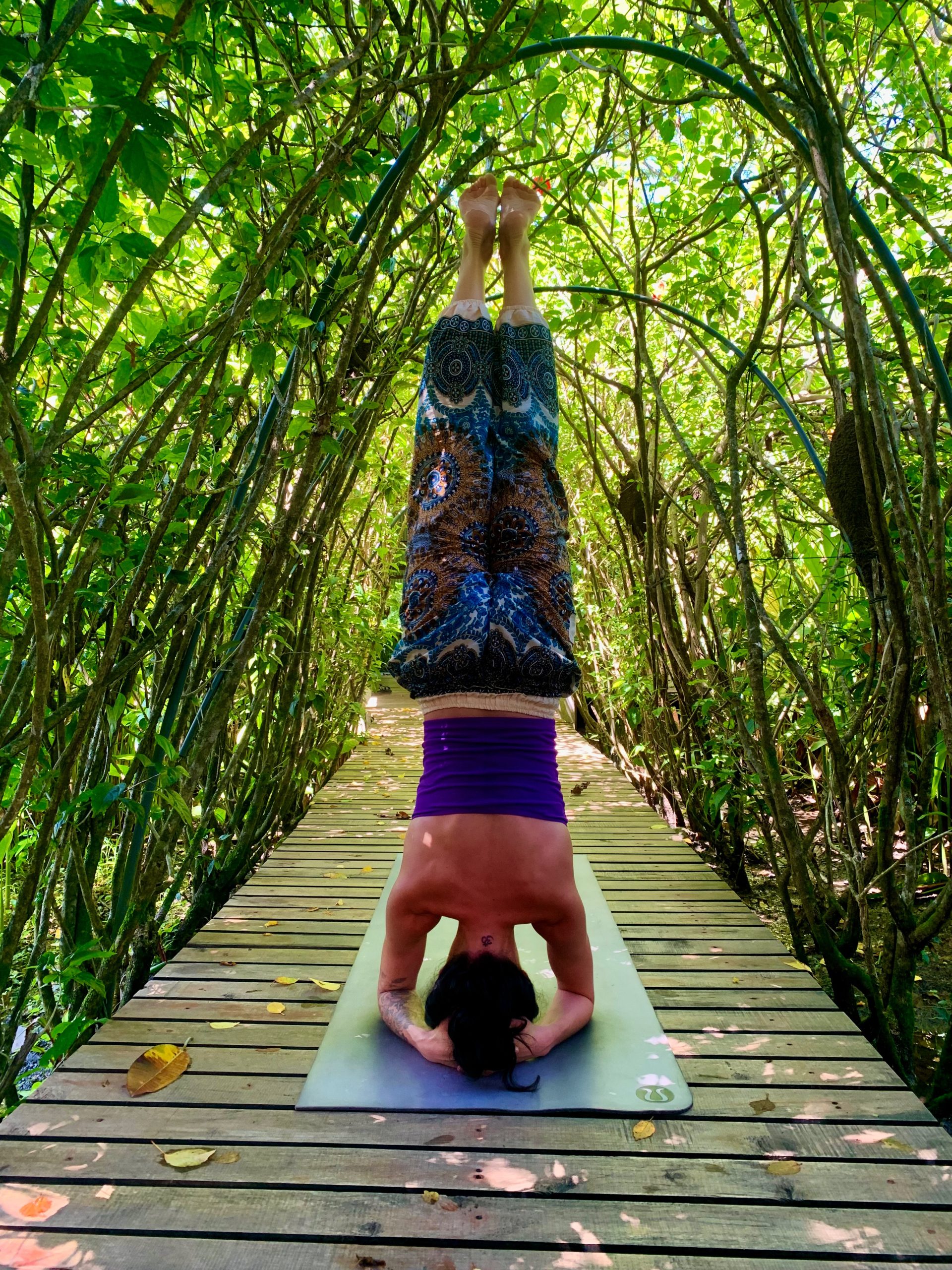
Crystal McKinney has a bachelor of science in kinesiology and is a 500-hour registered yoga teacher.
Please provide your feedback here
control of center of total body weight in relation to base of support. also referred to as postural stability
weighted average of each body segment to determine center point of total body mass.
control of body alignment in space to maintain stability and orientation
maintaining body segments to body and environment for a task, also known as posture
vertical projection of center of mass
center point of force distributed across a system with base of support
body area in contact with the support surface
control of center of total body weight in relation to base of support. also referred to as balance
somatosense related to position and touch as well as sense of vibration, pain, temperature relayed to somatosensory areas of the parietal cortex
body's biomechanical alignment and orientation to environment
perception of visual stimulation contributed to the eye from nervous system and nonneural components including cornea, lens, retina, optic nerve, optic tract, visual area of cerebral cortex
regulation of locomotion and body movement in relation to orientation, balance, and posture that consist of vestibular nerve in inner ear and processing of postural stability information
visual, vestibular, or somatosensory feedback
force of resistance in lengthening of muscle, stiffness
increased activity of antigravity postural muscles against force of gravity
movement strategy in anticipation response of voluntary movement that may disrupt postural stability
movement strategy of postural control in response to sensory feedback from task or environment